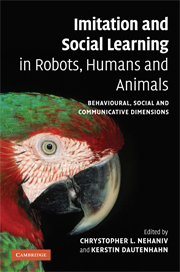 Imitation and Social Learning in Robots, Humans and Animals
Imitation and Social Learning in Robots, Humans and Animals Published online by Cambridge University Press: 10 December 2009
Getting a robot to imitate is a difficult task. Currently, researchers are tackling difficult issues such as the ‘correspondence problem’ (Nehaniv and Dautenhahn, 2002) of how to map different aspects of a demonstration to one's own imitative response, how to decide whom, when and what to imitate, and how to evaluate success (Dautenhahn and Nehaniv, 2002a, b). From our perspective, the most interesting of these issues is the question of what to imitate, that is, which aspects of a demonstration robots should copy. This is because in many situations, instead of copying others' actions and their results on the environment exactly, it is often more useful to extract and adopt the goal of the demonstrator's actions, and only copy the actions and results of the demonstrator if they are intended and relevant or essential to the task.
To illustrate, imagine the following scenarios. A robot is presented with the following demonstration and then told to imitate.
(1) An actor approaches a lever and pushes it with his foot.
Here, copying the actor's action and its result might be appropriate: the robot should also push the lever with its foot (assuming it has one).
(2) An actor whose arms are broken pushes the lever with his foot.
Now it might be more appropriate for the robot to use a different action to achieve the same result: it could push the lever with its hands (assuming it has them), as the constraint of not having usable hands – the normal thing to use to push things – does not apply to it.
[…]
To save this book to your Kindle, first ensure [email protected] is added to your Approved Personal Document E-mail List under your Personal Document Settings on the Manage Your Content and Devices page of your Amazon account. Then enter the ‘name’ part of your Kindle email address below. Find out more about saving to your Kindle.
Note you can select to save to either the @free.kindle.com or @kindle.com variations. ‘@free.kindle.com’ emails are free but can only be saved to your device when it is connected to wi-fi. ‘@kindle.com’ emails can be delivered even when you are not connected to wi-fi, but note that service fees apply.
Find out more about the Kindle Personal Document Service.
To save content items to your account, please confirm that you agree to abide by our usage policies. If this is the first time you use this feature, you will be asked to authorise Cambridge Core to connect with your account. Find out more about saving content to Dropbox.
To save content items to your account, please confirm that you agree to abide by our usage policies. If this is the first time you use this feature, you will be asked to authorise Cambridge Core to connect with your account. Find out more about saving content to Google Drive.